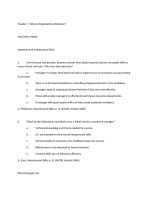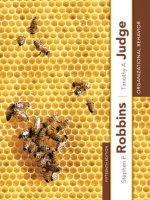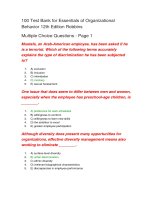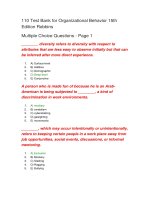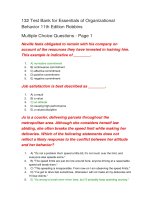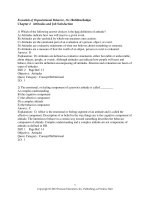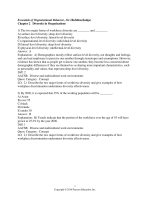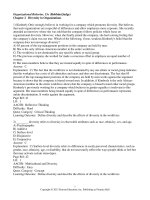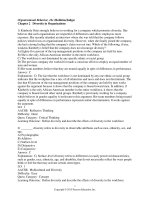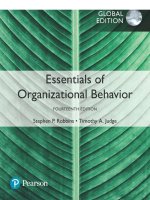organizational behavior 15e stephen robbins timothy a judge
Bạn đang xem bản rút gọn của tài liệu. Xem và tải ngay bản đầy đủ của tài liệu tại đây (22.57 MB, 711 trang )
Organizational
Behavior
This page intentionally left blank
Organizational
Behavior
EDITION
15
Stephen P. Robbins
—San Diego State University
Timothy A. Judge
—University of Notre Dame
i3iEi35Bj!
Boston Columbus Indianapolis New York San Francisco Upper Saddle River
Amsterdam Cape Town Dubai London Madrid Milan Munich Paris Montreal Toronto
Delhi Mexico City Sao Paulo Sydney Hong Kong Seoul Singapore Taipei Tokyo
Editorial Director: Sally Yagan
Director of Editorial Services:
Ashley Santora
Acquisitions Editor: Brian Mickelson
Editorial Project Manager: Sarah Holle
Editorial Assistant: Ashlee Bradbury
VP Director of Marketing:
Patrice Lumumba Jones
Senior Marketing Manager:
Nikki Ayana Jones
Senior Managing Editor: Judy Leale
Production Project Manager:
Becca Groves
Senior Operations Supervisor:
Arnold Vila
Operations Specialist: Cathleen Petersen
Senior Art Director: Janet Slowik
Art Director: Kenny Beck
Text and Cover Designer: Wanda Espana
OB Poll Graphics: Electra Graphics
Cover Art: honey comb and a bee working /
Shutterstock / LilKar
Sr. Media Project Manager, Editorial:
Denise Vaughn
Media Project Manager, Production:
Lisa Rinaldi
Full-Service Project Management:
Christian Holdener, S4Carlisle Publishing
Services
Composition: S4Carlisle Publishing
Services
Printer/Binder: Courier/Kendallville
Cover Printer: Courier/Kendalville
Text Font: 10.5/12 ITC New Baskerville Std
Credits and acknowledgments borrowed from other sources and reproduced, with permission, in this
textbook appear on the appropriate page within text.
Copyright © 2013, 2011, 2009, 2007, 2005 by Pearson Education, Inc., publishing as
Prentice Hall. All rights reserved. Manufactured in the United States of America. This publication is
protected by Copyright, and permission should be obtained from the publisher prior to any prohibited
reproduction, storage in a retrieval system, or transmission in any form or by any means, electronic,
mechanical, photocopying, recording, or likewise. To obtain permission(s) to use material from this
work, please submit a written request to Pearson Education, Inc., Permissions Department, One Lake
Street, Upper Saddle River, New Jersey 07458, or you may fax your request to 201-236-3290.
Many of the designations by manufacturers and sellers to distinguish their products are claimed as
trademarks. Where those designations appear in this book, and the publisher was aware of a trademark claim, the designations have been printed in initial caps or all caps.
Library of Congress Cataloging-in-Publication Data
Robbins, Stephen P.
Organizational behavior / Stephen P. Robbins, Timothy A. Judge. — 15th ed.
p. cm.
Includes indexes.
ISBN-13: 978-0-13-283487-2
ISBN-10: 0-13-283487-1
1. Organizational behavior. I. Judge, Tim. II. Title.
HD58.7.R62 2012
658.3—dc23
2011038674
10 9 8 7 6 5 4 3 2 1
ISBN 10:
0-13-283487-1
ISBN 13: 978-0-13-283487-2
Brief Contents
Preface
1
xxii
Introduction
1
2
The Individual
2
3
4
5
6
7
8
3
What Is Organizational Behavior? 3
Diversity in Organizations 39
Attitudes and Job Satisfaction 69
Emotions and Moods 97
Personality and Values 131
Perception and Individual Decision Making 165
Motivation Concepts 201
Motivation: From Concepts to Applications 239
The Group
9
10
11
12
13
14
15
Foundations of Group Behavior 271
Understanding Work Teams 307
Communication 335
Leadership 367
Power and Politics 411
Conflict and Negotiation 445
Foundations of Organization Structure 479
v
vi
BRIEF CONTENTS
4
The Organization System
16 Organizational Culture 511
17 Human Resource Policies and Practices 543
18 Organizational Change and Stress Management
Appendix A Research in Organizational Behavior
Comprehensive Cases
Indexes
Glindex
637
663
623
577
616
Contents
Preface
1
1
xxii
Introduction
What Is Organizational Behavior?
3
The Importance of Interpersonal Skills 4
What Managers Do 5
Management Functions 6 • Management Roles 6 • Management
Skills 8 • Effective versus Successful Managerial Activities 8 • A Review
of the Manager’s Job 9
Enter Organizational Behavior 10
Complementing Intuition with Systematic Study 11
Disciplines That Contribute to the OB Field 13
Psychology 14 • Social Psychology 14 • Sociology 14 • Anthropology 14
There Are Few Absolutes in OB 14
Challenges and Opportunities for OB 15
Responding to Economic Pressures 15 • Responding to Globalization 16
• Managing Workforce Diversity 18 • Improving Customer
Service 18 • Improving People Skills 19 • Stimulating Innovation
and Change 20 • Coping with “Temporariness” 20 • Working in
Networked Organizations 20 • Helping Employees Balance Work–Life
Conflicts 21 • Creating a Positive Work Environment 22 • Improving
Ethical Behavior 22
Coming Attractions: Developing an OB Model 23
An Overview 23 • Inputs 24 • Processes 25 • Outcomes 25
Summary and Implications for Managers 30
S A
L
Self-Assessment Library How Much Do I Know About Organizational Behavior? 4
Myth or Science? “Most Acts of Workplace Bullying Are Men Attacking Women” 12
An Ethical Choice Can You Learn from Failure? 24
glOBalization! Does National Culture Affect Organizational Practices? 30
Point/Counterpoint Lost in Translation? 31
Questions for Review 32
Experiential Exercise Workforce Diversity 32
Ethical Dilemma Jekyll and Hyde 33
Case Incident 1 “Lessons for ‘Undercover’ Bosses” 34
Case Incident 2 Era of the Disposable Worker? 35
vii
viii
CONTENTS
2
2
The Individual
Diversity in Organizations
39
Diversity 40
Demographic Characteristics of the U.S. Workforce 41 • Levels
of Diversity 42 • Discrimination 42
Biographical Characteristics 44
Age 44 • Sex 46 • Race and Ethnicity 48 • Disability 48 • Other
Biographical Characteristics: Tenure, Religion, Sexual Orientation,
and Gender Identity 50
Ability 52
Intellectual Abilities 52 • Physical Abilities 55 • The Role of Disabilities 56
Implementing Diversity Management Strategies 56
Attracting, Selecting, Developing, and Retaining Diverse
Employees 56 • Diversity in Groups 58 • Effective Diversity Programs 58
Summary and Implications for Managers 60
S A
L
Self-Assessment Library What’s My Attitude Toward Older People? 40
Myth or Science? “Dual-Career Couples Divorce Less” 47
An Ethical Choice Religious Tattoos 51
glOBalization! Images of Diversity from Around the Globe 54
Point/Counterpoint Men Have More Mathematical Ability Than Women 61
Questions for Review 62
Experiential Exercise Feeling Excluded 62
Ethical Dilemma Board Quotas 62
Case Incident 1 The Flynn Effect 63
Case Incident 2 Increasing Age Diversity in the Workplace 64
3
Attitudes and Job Satisfaction
69
Attitudes 70
What Are the Main Components of Attitudes? 70 • Does Behavior Always
Follow from Attitudes? 71 • What Are the Major Job Attitudes? 73
Job Satisfaction 78
Measuring Job Satisfaction 79 • How Satisfied Are People in Their
Jobs? 80 • What Causes Job Satisfaction? 81 • The Impact of Satisfied
and Dissatisfied Employees on the Workplace 82
Summary and Implications for Managers 88
S A
L
Self-Assessment Library How Satisfied Am I with My Job? 70
CONTENTS
S A
L
ix
An Ethical Choice Do Employers Owe Workers More Satisfying Jobs? 74
glOBalization! Culture and Work–Life Balance 76
Self-Assessment Library Am I Engaged? 78
Myth or Science? “Favorable Job Attitudes Make Organizations More Profitable” 83
Point/Counterpoint Employer–Employee Loyalty Is an Outdated Concept 87
Questions for Review 88
Experiential Exercise What Factors Are Most Important to Your Job Satisfaction? 89
Ethical Dilemma Bounty Hunters 89
Case Incident 1 Long Hours, Hundreds of E-Mails, and No Sleep:
Does This Sound Like a Satisfying Job? 90
Case Incident 2 Crafting a Better Job 91
4
Emotions and Moods
97
What Are Emotions and Moods? 98
The Basic Emotions 100 • The Basic Moods: Positive and Negative Affect 100
• The Function of Emotions 102 • Sources of Emotions and Moods 103
Emotional Labor 108
Affective Events Theory 110
Emotional Intelligence 112
The Case for EI 113 • The Case Against EI 114 • Emotion Regulation 115
OB Applications of Emotions and Moods 115
Selection 116 • Decision Making 116 • Creativity 116 • Motivation 117
• Leadership 117 • Negotiation 117 • Customer Service 118 • Job
Attitudes 119 • Deviant Workplace Behaviors 119 • Safety and Injury
at Work 119 • How Managers Can Influence Moods 120
Summary and Implications for Managers 121
S A
S A
L
L
Self-Assessment Library How Are You Feeling Right Now? 98
Self-Assessment Library What’s My Affect Intensity? 104
Myth or Science? We Are Better Judges of When Others Are Happy Than When
They Are Sad 107
glOBalization! Should You Expect “Service with a Smile” All Around the World? 108
Self-Assessment Library What’s My Emotional Intelligence Score? 115
An Ethical Choice Schadenfreude 120
Point/Counterpoint Sometimes Blowing Your Top Is a Good Thing 122
Questions for Review 121
Experiential Exercise Who Can Catch a Liar? 123
Ethical Dilemma Happiness Coaches for Employees 123
Case Incident 1 Is It Okay to Cry at Work? 124
Case Incident 2 Can You Read Emotions from Faces? 124
5
Personality and Values
131
Personality 133
What Is Personality? 133 • The Myers-Briggs Type Indicator 135 • The Big
Five Personality Model 136 • Other Personality Traits Relevant to OB 139
x
CONTENTS
Values 144
The Importance of Values 144 • Terminal versus Instrumental
Values 144 • Generational Values 145
Linking an Individual’s Personality and Values to the Workplace 148
Person–Job Fit 148 • Person–Organization Fit 150
International Values 150
Summary and Implications for Managers 154
S A
L
Self-Assessment Library Am I a Narcissist? 132
Myth or Science? Personality Predicts the Performance of Entrepreneurs 142
glOBalization! The Right Personality for a Global Workplace 143
An Ethical Choice Should You Try to Change Someone’s Personality? 147
Point/Counterpoint Millennials Are More Narcissistic 155
Questions for Review 156
Experiential Exercise What Organizational Culture Do You Prefer? 156
Ethical Dilemma Freedom or Lack of Commitment? 156
Case Incident 1 Is There a Price for Being Too Nice? 157
Case Incident 2 Leadership from an Introvert’s Perspective 158
6
Perception and Individual Decision Making
165
What Is Perception? 166
Factors That Influence Perception 167
Person Perception: Making Judgments About Others 168
Attribution Theory 168 • Common Shortcuts in Judging
Others 170 • Specific Applications of Shortcuts in Organizations 173
The Link Between Perception and Individual Decision Making 174
Decision Making in Organizations 175
The Rational Model, Bounded Rationality, and Intuition 175 • Common
Biases and Errors in Decision Making 177
Influences on Decision Making: Individual Differences and Organizational
Constraints 184
Individual Differences 184 • Organizational Constraints 186
What About Ethics in Decision Making? 187
Three Ethical Decision Criteria 187 • Improving Creativity in Decision
Making 188
Summary and Implications for Managers 190
S A
L
S A
L
S A
L
Self-Assessment Library What Are My Gender Role Perceptions? 166
glOBalization! Chinese Time, North American Time 171
Myth or Science? Creative Decision Making Is a Right-Brain Activity 181
Self-Assessment Library Am I A Deliberate Decision Maker? 183
An Ethical Choice Whose Ethical Standards to Follow? 185
Self-Assessment Library How Creative Am I? 190
Point/Counterpoint Checklists Lead to Better Decisions 191
CONTENTS
xi
Questions for Review 192
Experiential Exercise Biases in Decision Making 193
Ethical Dilemma Do Unethical Decisions Come from Bad Character? 193
Case Incident 1 Computerized Decision Making 194
Case Incident 2 Predictions That Didn’t Quite Pan Out 195
7
Motivation Concepts
201
Defining Motivation 202
Early Theories of Motivation 203
Hierarchy of Needs Theory 203 • Theory X and Theory Y 205 • Two-Factor
Theory 205 • McClelland’s Theory of Needs 207
Contemporary Theories of Motivation 208
Self-Determination Theory 208 • Job Engagement 211 • Goal-Setting
Theory 212 • Self-Efficacy Theory 215 • Reinforcement Theory 218 • Equity
Theory/Organizational Justice 219 • Expectancy Theory 224
Integrating Contemporary Theories of Motivation 226
Summary and Implications for Managers 228
S A
L
Self-Assessment Library How Confident Am I in My Abilities to Succeed? 202
Myth or Science? “The Support of Others Improves Our Chances of Accomplishing
Our Goals” 204
S A
L
An Ethical Choice Motivated to Behave Unethically 209
glOBalization! Autonomy Needs Around the Globe 210
Self-Assessment Library What Are My Course Performance Goals? 214
Point/Counterpoint Fear Is a Powerful Motivator 229
Questions for Review 230
Experiential Exercise Goal-Setting Task 230
Ethical Dilemma The Big Easy? 230
Case Incident 1 It’s Not Fair! 231
Case Incident 2 Bullying Bosses 231
8
Motivation: From Concepts to Applications
239
Motivating by Job Design: The Job Characteristics Model 240
The Job Characteristics Model 240 • How Can Jobs Be
Redesigned? 242 • Alternative Work Arrangements 245 • The Social and
Physical Context of Work 249
Employee Involvement 250
Examples of Employee Involvement Programs 251 • Linking Employee
Involvement Programs and Motivation Theories 252
Using Rewards to Motivate Employees 252
What to Pay: Establishing a Pay Structure 252 • How to Pay: Rewarding
Individual Employees Through Variable-Pay Programs 253 • Flexible
xii
CONTENTS
Benefits: Developing a Benefits Package 257 • Intrinsic Rewards: Employee
Recognition Programs 259
Summary and Implications for Managers 261
S A
L
Self-Assessment Library What’s My Job’s Motivating Potential? 240
Myth or Science? “CEO Pay Can’t Be Measured” 243
An Ethical Choice Identifying Conflicts of Interest 258
glOBalization! Motivated by Individual Goals or Relational Goals? 260
Point/Counterpoint “If Money Doesn’t Make You Happy, You Aren’t Spending It Right” 262
Questions for Review 263
Experiential Exercise Assessing Employee Motivation and Satisfaction Using
the Job Characteristics Model 263
Ethical Dilemma Spitting Mad 264
Case Incident 1 Multitasking: A Good Use of Your Time? 264
Case Incident 2 Bonuses Can Backfire 265
3
9
The Group
Foundations of Group Behavior
271
Defining and Classifying Groups 272
Why Do People Form Groups? 272
Stages of Group Development 274
The Five-Stage Model 275 • An Alternative Model for Temporary Groups
with Deadlines 276
Group Properties: Roles, Norms, Status, Size, Cohesiveness, and Diversity 277
Group Property 1: Roles 277 • Group Property 2: Norms 280 • Group
Property 3: Status 285 • Group Property 4: Size 286 • Group Property 5:
Cohesiveness 288 • Group Property 6: Diversity 288
Group Decision Making 290
Groups versus the Individual 290 • Groupthink and
Groupshift 292 • Group Decision-Making Techniques 295
Summary and Implications for Managers 296
S A
L
Self-Assessment Library Do I Have a Negative Attitude Toward Working in Groups? 272
Self-Assessment Library Do I Trust Others? 280
glOBalization! Forming International Teams in a Virtual World 291
Myth or Science? “Asians Have Less Ingroup Bias Than Americans” 292
An Ethical Choice Should You Use Group Peer Pressure? 294
Point/Counterpoint Affinity Groups Fuel Business Success 298
Questions for Review 297
Experiential Exercise Wilderness Survival 299
Ethical Dilemma Is Social Loafing Shirking? 300
Case Incident 1 Negative Aspects of Collaboration? 300
Case Incident 2 Herd Behavior and the Housing Bubble (and Collapse) 301
CONTENTS
10
Understanding Work Teams
307
Why Have Teams Become So Popular? 308
Differences Between Groups and Teams 309
Types of Teams 310
Problem-Solving Teams 310 • Self-Managed Work Teams 310
• Cross-Functional Teams 311 • Virtual Teams 312
Creating Effective Teams 312
Context: What Factors Determine Whether Teams Are Successful 313
• Team Composition 315 • Team Processes 319
Turning Individuals into Team Players 322
Selecting: Hiring Team Players 323 • Training: Creating Team
Players 324 • Rewarding: Providing Incentives to Be a Good Team
Player 324
Beware! Teams Aren’t Always the Answer 324
Summary and Implications for Managers 325
S A
L
S A
L
Self-Assessment Library How Good Am I at Building and Leading a Team? 308
glOBalization! Group Cohesiveness across Cultures 314
An Ethical Choice Using Global Virtual Teams as an Environmental Choice 315
Myth or Science? “Teams Work Best Under Angry Leaders” 320
Self-Assessment Library What Is My Team Efficacy? 322
Point/Counterpoint We Can Learn Much About Work Teams from Studying
Sports Teams 326
Questions for Review 327
Experiential Exercise Fixed versus Variable Flight Crews 327
Ethical Dilemma Unethical Teams 327
Case Incident 1 Why Don’t Teams Work Like They’re Supposed to? 328
Case Incident 2 Multicultural Multinational Teams at IBM 329
11
Communication
335
Functions of Communication 336
The Communication Process 338
Direction of Communication 338
Downward Communication 339 • Upward Communication 339
• Lateral Communication 339
Interpersonal Communication 340
Oral Communication 340 • Written Communication 341
• Nonverbal Communication 341
Organizational Communication 342
Formal Small-Group Networks 343 • The Grapevine 343
• Electronic Communications 345 • Managing Information 349
Choice of Communication Channel 350
xiii
xiv
CONTENTS
Persuasive Communications 351
Automatic and Controlled Processing 351 • Interest Level 352
• Prior Knowledge 352 • Personality 352 • Message Characteristics 352
Barriers to Effective Communication 353
Filtering 353 • Selective Perception 353 • Information
Overload 353 • Emotions 353 • Language 354 • Silence 354
• Communication Apprehension 355 • Lying 355
Global Implications 356
Cultural Barriers 356 • Cultural Context 357 • A Cultural Guide 358
Summary and Implications for Managers 360
S A
L
S A
L
Self-Assessment Library Am I a Gossip? 336
An Ethical Choice The Ethics of Gossip at Work 345
Myth or Science? “We Know What Makes Good Liars Good” 356
glOBalization! How Direct Should You Be? 358
Point/Counterpoint Social Networking Is Good Business 359
Self-Assessment Library How Good Are My Listening Skills? 360
Questions for Review 360
Experiential Exercise An Absence of Nonverbal Communication 361
Ethical Dilemma Pitfalls of E-Mail 361
Case Incident 1 Using Social Media to Your Advantage 362
Case Incident 2 Should Companies That Fire Shoot First? 362
12
Leadership
367
What Is Leadership? 368
Trait Theories 369
Behavioral Theories 370
Summary of Trait Theories and Behavioral Theories 372
Contingency Theories 372
The Fiedler Model 373 • Other Contingency Theories 375
Leader–Member Exchange (LMX) Theory 377
Charismatic Leadership and Transformational Leadership 379
Charismatic Leadership 379 • Transformational Leadership 382
Authentic Leadership: Ethics and Trust 386
What Is Authentic Leadership? 386 • Ethics and Leadership 386 • Servant
Leadership 387 • Trust and Leadership 387 • How Is Trust Developed? 389
• Trust as a Process 390 • What Are the Consequences of Trust? 390
Leading for the Future: Mentoring 391
Mentoring 391
Challenges to the Leadership Construct 393
Leadership as an Attribution 393 • Substitutes for and Neutralizers
of Leadership 394 • Online Leadership 395
Finding and Creating Effective Leaders 396
Selecting Leaders 396 • Training Leaders 396
CONTENTS
Summary and Implications for Managers 397
S A
L
S A
L
Self-Assessment Library What’s My Leadership Style? 368
Self-Assessment Library What’s My LPC Score? 373
glOBalization! Cross-Cultural Leadership Styles 378
Self-Assessment Library How Charismatic Am I? 382
Self-Assessment Library Am I an Ethical Leader? 386
An Ethical Choice Do Leaders Have a Responsibility to Protect
Followers? 388
Myth or Science? “Power Helps Leaders Perform Better” 392
Point/Counterpoint Heroes Are Made, Not Born 398
Questions for Review 399
Experiential Exercise What Is a Leader? 399
Ethical Dilemma Undercover Leaders 399
Case Incident 1 Leadership Mettle Forged in Battle 400
Case Incident 2 Leadership Factories 400
13
Power and Politics
411
A Definition of Power 412
Contrasting Leadership and Power 413
Bases of Power 414
Formal Power 414 • Personal Power 415 • Which Bases of Power Are
Most Effective? 416 • Power and Perceived Justice 416
Dependence: The Key to Power 416
The General Dependence Postulate 416 • What Creates Dependence? 417
Power Tactics 418
Sexual Harassment: Unequal Power in the Workplace 421
Politics: Power in Action 424
Definition of Organizational Politics 424 • The Reality of Politics 424
Causes and Consequences of Political Behavior 426
Factors Contributing to Political Behavior 426 • How Do People Respond
to Organizational Politics? 429 • Impression Management 430
The Ethics of Behaving Politically 434
Summary and Implications for Managers 435
S A
L
S A
L
Self-Assessment Library Is My Workplace Political? 412
glOBalization! Power Distance and Innovation 420
An Ethical Choice Should All Sexual Behavior Be Prohibited at Work? 423
Myth or Science? “Corporate Political Activity Pays” 428
Self-Assessment Library How Good Am I at Playing Politics? 430
Point/Counterpoint Power Corrupts People 436
Questions for Review 437
Experiential Exercise Understanding Power Dynamics 437
Ethical Dilemma Corporate Spying 438
Case Incident 1 Delegate Power, or Keep It Close? 438
Case Incident 2 The Persuasion Imperative 439
xv
xvi
CONTENTS
14
Conflict and Negotiation
445
A Definition of Conflict 446
Transitions in Conflict Thought 447
The Traditional View of Conflict 447 • The Interactionist View
of Conflict 447 • Resolution-Focused View of Conflict 449
The Conflict Process 449
Stage I: Potential Opposition or Incompatibility 450 • Stage II: Cognition
and Personalization 451 • Stage III: Intentions 452 • Stage IV:
Behavior 454 • Stage V: Outcomes 455
Negotiation 458
Bargaining Strategies 458 • The Negotiation Process 463
• Individual Differences in Negotiation Effectiveness 464 • Third-Party
Negotiations 467
Summary and Implications for Managers 469
S A
S A
L
L
Self-Assessment Library What’s My Preferred Conflict-Handling Style? 446
Myth or Science? “Communicating Well Is More Important in Cross-Cultural
Negotiations” 462
glOBalization! Anger and Conflict Across Cultures 467
Self-Assessment Library What’s My Negotiating Style? 467
An Ethical Choice Using Empathy to Negotiate More Ethically 468
Point/Counterpoint Player–Owner Disputes Are Unnecessary 471
Questions for Review 472
Experiential Exercise A Negotiation Role-Play 472
Ethical Dilemma The Lowball Applicant 473
Case Incident 1 Choosing Your Battles 473
Case Incident 2 Mediation: Master Solution to Employment Disputes? 474
15
Foundations of Organization Structure
479
What Is Organizational Structure? 480
Work Specialization 480 • Departmentalization 482 • Chain
of Command 483 • Span of Control 484 • Centralization and
Decentralization 485 • Formalization 486
Common Organizational Designs 486
The Simple Structure 486 • The Bureaucracy 487 • The Matrix Structure 488
New Design Options 490
The Virtual Organization 490 • The Boundaryless Organization 492
• The Leaner Organization: Downsizing 494
Why Do Structures Differ? 496
Organizational Strategy 496 • Organization Size 498 • Technology 498
• Environment 499
Organizational Designs and Employee Behavior 501
Summary and Implications for Managers 502
CONTENTS
S A
L
xvii
Self-Assessment Library Do I Like Bureaucracy? 480
Self-Assessment Library How Willing Am I to Delegate? 486
glOBalization! The Global Organization 489
An Ethical Choice Downsizing with a Conscience 496
Myth or Science? “Employees Resent Outsourcing” 500
Point/Counterpoint The End of Management 503
Questions for Review 504
Experiential Exercise Dismantling a Bureaucracy 504
Ethical Dilemma Directing the Directors 505
Case Incident 1 Creative Deviance: Bucking the Hierarchy? 506
Case Incident 2 Siemens’ Simple Structure—Not 506
4
16
The Organization System
Organizational Culture
511
What Is Organizational Culture? 512
A Definition of Organizational Culture 512 • Culture Is a Descriptive
Term 514 • Do Organizations Have Uniform Cultures? 514 • Strong versus
Weak Cultures 514 • Culture versus Formalization 515
What Do Cultures Do? 516
Culture’s Functions 516 • Culture Creates Climate 516 • Culture as a
Liability 517
Creating and Sustaining Culture 519
How a Culture Begins 519 • Keeping a Culture Alive 519 • Summary:
How Cultures Form 523
How Employees Learn Culture 523
Stories 523 • Rituals 524 • Material Symbols 524 • Language 524
Creating an Ethical Organizational Culture 525
Creating a Positive Organizational Culture 527
Spirituality and Organizational Culture 529
What Is Spirituality? 529 • Why Spirituality Now? 530 • Characteristics
of a Spiritual Organization 530 • Achieving a Spiritual
Organization 531 • Criticisms of Spirituality 531
Global Implications 532
Summary and Implications for Managers 533
S A
L
Self-Assessment Library What’s the Right Organizational Culture for Me? 512
glOBalization! Face Culture, Dignity Culture, and Organizational Culture 515
Myth or Science? “Employees Treat Customers the Same Way the Organization
Treats Them” 518
An Ethical Choice Designing a Culture of Ethical Voice 526
xviii
CONTENTS
S A
L
Self-Assessment Library How Spiritual Am I? 531
Point/Counterpoint Organizations Should Strive to Create a Positive
Organizational Culture 534
Questions for Review 535
Experiential Exercise Rate Your Classroom Culture 535
Ethical Dilemma A Bankrupt Culture 536
Case Incident 1 Mergers Don’t Always Lead to Culture Clashes 536
Case Incident 2 Did Toyota’s Culture Cause Its Problems? 537
17
Human Resource Policies and Practices
543
Selection Practices 544
How the Selection Process Works 544 • Initial Selection 545 • Substantive
Selection 546 • Contingent Selection 549 • International Variations
in Selection Processes 550
Training and Development Programs 551
Types of Training 551 • Training Methods 553 • Evaluating
Effectiveness 554
Performance Evaluation 554
What Is Performance? 555 • Purposes of Performance
Evaluation 555 • What Do We Evaluate? 555 • Who Should Do the
Evaluating? 556 • Methods of Performance Evaluation 558 • Suggestions
for Improving Performance Evaluations 560 • Providing Performance
Feedback 562 • International Variations in Performance Appraisal 563
Managing Work–Life Conflicts in Organizations 563
Summary and Implications for Managers 566
S A
L
S A
L
Self-Assessment Library How Much Do I Know About Human Resource
Management (HRM)? 544
glOBalization! Performance Appraisal Around the World 558
An Ethical Choice Recruiting the Unemployed 561
Self-Assessment Library How Good Am I at Giving Performance Feedback? 563
Myth or Science? “Work Is Making Us Fat” 564
Point/Counterpoint Social Media Is a Great Source of New Hires 567
Questions for Review 568
Experiential Exercise Evaluating Performance and Providing Feedback 568
Ethical Dilemma Credit Checking 568
Case Incident 1 The End of the Performance Appraisal? 569
Case Incident 2 Job Candidates Without Strong SAT Scores Need Not Apply 570
18
Organizational Change and Stress Management
577
Forces for Change 578
Planned Change 580
Resistance to Change 580
Overcoming Resistance to Change 582 • The Politics of Change 584
CONTENTS
xix
Approaches to Managing Organizational Change 584
Lewin’s Three-Step Model 584 • Kotter’s Eight-Step Plan for Implementing
Change 586 • Action Research 587 • Organizational Development 587
Creating a Culture for Change 591
Stimulating a Culture of Innovation 591 • Creating a Learning
Organization 593
Work Stress and Its Management 595
What Is Stress? 595 • Potential Sources of Stress 597 • Individual
Differences 599 • Cultural Differences 600 • Consequences of Stress 601
• Managing Stress 602
Summary and Implications for Managers 606
S A
L
S A
L
Self-Assessment Library How Well Do I Respond to Turbulent Change? 578
Myth or Science? “Men Experience More Job Stress Than Women” 596
Self-Assessment Library How Stressful Is My Life? 600
An Ethical Choice Responsibly Managing Your Own Stress 601
glOBalization! Work–Family Stress in Different Cultures 604
Point/Counterpoint Responsible Managers Relieve Stress on Their Employees 607
Questions for Review 608
Experiential Exercise Power and the Changing Environment 608
Ethical Dilemma Changes at WPAC 609
Case Incident 1 Starbucks Returns to Its Roots 610
Case Incident 2 The Rise of Extreme Jobs 610
Appendix A
Research in Organizational Behavior 616
Comprehensive Cases
Indexes
Glindex
637
663
623
About the Authors
Stephen P. Robbins
Education
Ph.D. University of Arizona
Professional Experience
Academic Positions: Professor, San Diego State University, Southern Illinois
University at Edwardsville, University of Baltimore, Concordia University in
Montreal, and University of Nebraska at Omaha.
Research: Research interests have focused on conflict, power, and politics in
organizations, behavioral decision making, and the development of effective
interpersonal skills.
Books Published: World’s best-selling author of textbooks in both management
and organizational behavior. His books have sold more than 5 million copies
and have been translated into 20 languages; editions have been adapted for
Canada, Australia, South Africa, and India, such as these:
•
•
•
•
•
•
•
•
•
•
•
Essentials of Organizational Behavior, 11th ed. (Prentice Hall, 2012)
Management, 11th ed. with Mary Coulter (Prentice Hall, 2012)
Fundamentals of Human Resource Management, 10th ed., with David DeCenzo
(Wiley, 2010)
Prentice Hall’s Self-Assessment Library 3.4 (Prentice Hall, 2010)
Fundamentals of Management, 8th ed., with David DeCenzo and Mary Coulter
(Prentice Hall, 2013)
Supervision Today! 7th ed., with David DeCenzo and Robert Wolter (Prentice
Hall, 2013)
Training in Interpersonal Skills: TIPS for Managing People at Work, 6th ed., with
Phillip Hunsaker (Prentice Hall, 2012)
Managing Today! 2nd ed. (Prentice Hall, 2000)
Organization Theory, 3rd ed. (Prentice Hall, 1990)
The Truth About Managing People, 2nd ed. (Financial Times/Prentice Hall,
2008)
Decide and Conquer: Make Winning Decisions and Take Control of Your Life
(Financial Times/Prentice Hall, 2004).
Other Interests
In his “other life,” Dr. Robbins actively participates in masters’ track competition. Since turning 50 in 1993, he has won 18 national championships and
12 world titles. He is the current world record holder at 100 meters (12.37 seconds)
and 200 meters (25.20 seconds) for men 65 and over.
xx
ABOUT THE AUTHORS
xxi
Timothy A. Judge
Education
Ph.D., University of Illinois at Urbana-Champaign
Professional Experience
Academic Positions: Franklin D. Schurz Chair, Department of Management,
Mendoza College of Business, University of Notre Dame; Matherly-McKethan
Eminent Scholar in Management, Warrington College of Business Administration, University of Florida; Stanley M. Howe Professor in Leadership, Henry B.
Tippie College of Business, University of Iowa; Associate Professor (with tenure),
Department of Human Resource Studies, School of Industrial and Labor Relations, Cornell University; Lecturer, Charles University, Czech Republic, and Comenius University, Slovakia; Instructor, Industrial/Organizational Psychology,
Department of Psychology, University of Illinois at Urbana-Champaign.
Research: Dr. Judge’s primary research interests are in (1) personality, moods,
and emotions; (2) job attitudes; (3) leadership and influence behaviors; and
(4) careers (person–organization fit, career success). Dr. Judge has published
more than 140 articles on these and other major topics in journals such as Journal of Organizational Behavior, Personnel Psychology, Academy of Management Journal,
Journal of Applied Psychology, European Journal of Personality, and European Journal
of Work and Organizational Psychology.
Fellowship: Dr. Judge is a fellow of the American Psychological Association,
the Academy of Management, the Society for Industrial and Organizational
Psychology, and the American Psychological Society.
Awards: In 1995, Dr. Judge received the Ernest J. McCormick Award for
Distinguished Early Career Contributions from the Society for Industrial and
Organizational Psychology. In 2001, he received the Larry L. Cummings Award
for mid-career contributions from the Organizational Behavior Division of the
Academy of Management. In 2007, he received the Professional Practice Award
from the Institute of Industrial and Labor Relations, University of Illinois.
Books Published: H. G. Heneman III, T. A. Judge, and J. D. Kammeyer-Mueller,
Staffing Organizations, 7th ed. (Madison, WI: Mendota House/Irwin, 2011)
Other Interests
Although he cannot keep up (literally!) with Dr. Robbin’s accomplishments on
the track, Dr. Judge enjoys golf, cooking and baking, literature (he’s a particular fan of Thomas Hardy and is a member of the Thomas Hardy Society), and
keeping up with his three children, who range in age from 23 to 9.
Preface
Welcome to the fifteenth edition of Organizational Behavior! Long considered
the standard for all organizational behavior textbooks, this edition continues
its tradition of making current, relevant research come alive for students. While
maintaining its hallmark features—clear writing style, cutting-edge content, and
engaging pedagogy—the fourteenth edition has been updated to reflect the most
recent research within the field of organizational behavior. This is one of the
most comprehensive and thorough revisions of Organizational Behavior we’ve undertaken, and while we’ve preserved the core material, we’re confident that this
edition reflects the most important research and topical issues facing organizations, managers, and employees.
Key Changes to the Fifteenth Edition
•
The most substantial updating ever. The following sections of each chapter
are new to the fifteenth edition:
• Opening Vignette
• Myth or Science?
• Ethical Choice
• Point/Counterpoint
• Case Incident
•
In addition, the following material is substantially revised and updated:
• Case Incident (those not entirely new are revised and updated)
• OB Poll (more than half are new to this edition)
• Ethical Dilemma (more than half are new to this edition)
• Photos/captions (more than half are new to this edition)
•
New feature: glOBalization!, which features organizational behavior in an
international context.
Improved integration of global implications: With the explosion of international research, global OB research is now woven into each chapter, rather
than in a stand-alone section at the end of the chapter.
Revision to Summary and Implications for Managers section, with more
focus on practical ways to apply the material on the job.
NEW videos—up-to-date videos showing management topics in action,
access to the complete management video library, as well as instructional
materials for integrating clips from popular movies into your class, are at
www.mymanagementlab.com.
•
•
•
Chapter-by-Chapter Changes
Chapter 1: What Is Organizational Behavior?
•
Entirely new Opening Vignette (The New Normal?)
•
New feature: glOBalization!
•
New Myth or Science? (“Most Acts of Workplace Bullying Are Men Attacking
Women”)
•
New OB Model, with better integration with pedagogy (structure) of book
xxii
PREFACE
•
•
•
•
xxiii
New Point–Counterpoint (Lost in Translation?)
New An Ethical Choice (Can You Learn from Failure?)
New Case Incident (Lessons for ‘Undercover’ Bosses)
New Case Incident (Era of the Disposable Worker?)
Chapter 2: Diversity in Organizations
•
Entirely new Opening Vignette (The Rise and Fall of Erin Callan)
•
New feature: glOBalization!
•
New Myth or Science? (“Dual-Career Couples Divorce Less”)
•
Enhanced coverage of stereotyping and discrimination research
•
Revised content regarding age discrimination and implications of an aging
workforce
•
Updates to discussion of disability in the workplace
•
Expanded coverage of sexual orientation discrimination
•
New material and integration of diversity with international/cultural diversity
•
New Point–Counterpoint (Men Have More Mathematical Ability Than Women)
•
New An Ethical Choice (Religious Tattoos)
•
New Case Incident (Increasing Age Diversity in the Workplace)
•
Updated Case Incident (The Flynn Effect)
Chapter 3: Attitudes and Job Satisfaction
•
Entirely new Opening Vignette (What Does SAS Stand For?)
•
New feature: glOBalization!
•
New Myth or Science? (“Favorable Job Attitudes Make Organizations More
Profitable”)
•
Review of recent studies on within-person variation in job attitudes
•
New developments in organizational commitment
•
Updated material on organizational citizenship behaviors
•
New perspectives on attitudes and organizational performance
•
New ethical dilemma
•
New Point–Counterpoint (Employer–Employee Loyalty Is an Outdated
Concept)
•
New An Ethical Choice (Do Employers Owe Workers More Satisfying Jobs?)
•
New Case Incident (Crafting a Better Job)
•
Updated Case Incident (Long Hours, Hundreds of E-Mails, and No Sleep:
Does This Sound Like a Satisfying Job?)
Chapter 4: Emotions and Moods
•
Entirely new Opening Vignette (Love at Work: Taboo No More?)
•
New feature: glOBalization!
•
New Myth or Science? (“We Are Better Judges of When Others Are Happy
Than When They Are Sad”)
•
Revised introduction to the topic
•
Review of research on moods and employee attachment
•
New section on “moral emotions”
•
Discussion of emotion regulation strategies and their consequences
•
New research on gender and emotions
•
Updated content on emotional displays at work
•
New section on Emotional Intelligence, with substantially more coverage and a
new exhibit
•
New Point–Counterpoint (Sometimes Blowing Your Top Is a Good Thing)
•
New An Ethical Choice (Schadenfreude)
•
New Case Incident (Is It Okay to Cry at Work?)
•
Updated Case Incident (Can You Read Emotions from Faces?)
xxiv
PREFACE
Chapter 5: Personality and Values
•
Entirely new Opening Vignette (Changing of the Guard in Japan: Is it the Economy, or the Values?)
•
New feature: glOBalization!
•
New Myth or Science? (“Personality Predicts the Performance of Entrepreneurs”)
•
Introduces concepts related to dispositional self- and other-orientation
•
New material regarding vocational choices
•
New discussion of values and reactions to violations of employee values
•
Major revision regarding Hofstede’s model of culture and its consequences
•
Updated information on personality and expatriate success
•
New Point–Counterpoint (Millennials Are More Narcissistic)
•
New An Ethical Choice (Should You Try to Change Someone’s Personality?)
•
New Case Incident (Leadership from an Introvert’s Perspective)
•
Updated Case Incident (Is There a Price for Being Too Nice?)
Chapter 6: Perception and Individual Decision Making
•
Entirely new Opening Vignette (Do Machines Make Better Decisions?)
•
New feature: glOBalization!
•
New Myth or Science? (“Creative Decision Making Is a Right-Brain Activity”)
•
Review of recent work on self-serving biases
•
New information on stereotyping processes
•
Discussion of latest trends in decision errors research
•
Updated discussion of culture and perceptions
•
New section on Financial Decision Making and how it informs to understand
recent and current crises
•
New Experiential Exercise
•
New Point–Counterpoint (Checklists Lead to Better Decisions)
•
New An Ethical Choice (Whose Ethical Standards to Follow?)
•
New Case Incident (Computerized Decision Making)
•
Updated Case Incident (Predictions That Didn’t Quite Pan Out)
Chapter 7: Motivation Concepts
•
Entirely new Opening Vignette (The Motivations of the 99ers)
•
New feature: glOBalization!
•
New Myth or Science? (“The Support of Others Improves Our Chances of
Accomplishing Our Goals”)
•
New material on psychological need theories
•
Increased discussion of employee engagement
•
Updates to the discussion on goal-setting theory
•
New perspectives on equity and organizational justice
•
New Point–Counterpoint (Fear Is a Powerful Motivator)
•
New An Ethical Choice (Motivated to Behave Unethically)
•
New Case Incident (It’s Not Fair!)
•
Updated Case Incident (Bullying Bosses)
Chapter 8: Motivation: From Concepts to Applications
Entirely new Opening Vignette (Motivation Minus the Moolah)
•
New feature: glOBalization!
•
New Myth or Science? (“CEO Pay Can’t Be Measured”)
•
Updated discussion of job characteristics
•
New coverage of flextime, telecommuting, and related work practices
•
Revised discussion of employee empowerment and its effects
•
Discussion of innovations in gainsharing practices
•
